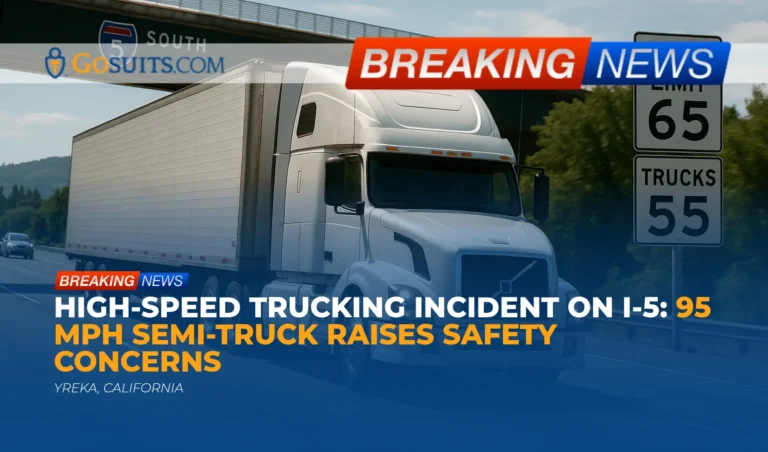A recent incident involving a commercial truck speeding on Interstate 5 (I-5) in California has brought renewed attention to the dangers of excessive speed, particularly for large vehicles. The California Highway Patrol (CHP) reported that a semi-truck was observed traveling at a staggering 95 miles per hour, a full 40 mph over the legal speed limit for trucks in the state. This incident, which occurred south of the Oregon border, highlights the potential for catastrophic accidents and the critical need for adherence to traffic laws within the trucking industry.
Details of the Incident
On July 18, 2025, the CHP’s Yreka Division issued a statement regarding the speeding violation, which took place earlier in the month. Troopers reported that the semi-truck was traveling southbound on I-5 at 95 mph. This speed is not only far beyond the legal limit of 55 mph for trucks with three or more axles in California but also significantly exceeds the posted speed limit for other vehicles on that stretch of highway. The CHP issued a citation to the truck driver on July 5, emphasizing the severe risks associated with such excessive speed.
Legal Implications and California Vehicle Code 22406
California Vehicle Code 22406 explicitly states that vehicles with three or more axles are capped at a speed limit of 55 mph on all highways, interstates, and freeways within the state, regardless of the posted speed limit for other vehicles. This law is in place due to the increased risk factors associated with large commercial trucks, including their greater weight, longer stopping distances, and potential for rollovers or jackknifing at high speeds.
A violation of Vehicle Code 22406 can result in significant penalties for the driver, including fines, points on their commercial driver’s license (CDL), and potential suspension or revocation of their driving privileges. Beyond the immediate penalties, such a violation can also have serious long-term consequences for a truck driver’s career and insurability.
Safety Concerns and Potential for Accidents
Excessive speed is a major contributing factor in truck accidents, and the higher the speed, the greater the risk of a collision and the severity of resulting injuries. A truck traveling at 95 mph requires a significantly longer stopping distance than one traveling at the legal limit. This increased stopping distance makes it much more difficult for the driver to react to sudden changes in traffic or road conditions, such as unexpected braking by other vehicles or the presence of debris on the roadway.
Furthermore, high speeds can lead to a loss of control, especially for a large, heavy vehicle like a semi-truck. The forces acting on the truck’s tires and suspension increase exponentially with speed, making it more likely that the driver will lose traction, particularly in adverse weather conditions or during sudden maneuvers. A truck accident at 95 mph could easily result in catastrophic injuries or fatalities, not only for the truck driver but also for occupants of other vehicles involved.

Factors Contributing to Truck Speeding
Several factors may contribute to truck speeding, including:
- Driver fatigue: Long hours behind the wheel and demanding delivery schedules can lead to fatigue, which impairs judgment and reaction time. Fatigued drivers may be more likely to speed in an attempt to make up time.
- Pressure to meet deadlines: Truck drivers often face pressure from their employers or clients to deliver goods on time. This pressure can incentivize drivers to speed in order to meet tight deadlines, even if it means violating traffic laws.
- Inadequate training: Insufficient training on safe driving practices and the dangers of speeding can also contribute to the problem. Drivers who are not fully aware of the risks associated with high speeds may be more likely to exceed the legal limit.
- Mechanical issues: In some cases, mechanical problems with the truck, such as faulty brakes or tires, can make it more difficult for the driver to control the vehicle, especially at high speeds.
Accountability and Liability
When a truck accident occurs due to speeding or other forms of negligence, multiple parties may be held liable for the resulting damages. These parties can include:
- The truck driver: The driver is directly responsible for operating the vehicle safely and in accordance with traffic laws. If the driver was speeding, fatigued, or otherwise negligent, they may be held liable for any resulting injuries or damages.
- The trucking company: Trucking companies have a responsibility to ensure that their drivers are properly trained, qualified, and supervised. If the company failed to adequately screen or train the driver, or if they pressured the driver to violate traffic laws, they may also be held liable.
- The owner of the cargo: In some cases, the owner of the cargo being transported may also be held liable if their actions contributed to the accident. For example, if the cargo was improperly loaded or secured, it could shift during transit and cause the truck to lose control.
- Manufacturers of defective parts: If the accident was caused by a defective part on the truck, the manufacturer of the part may be held liable.
Victims of truck accidents caused by speeding or other forms of negligence may be entitled to compensation for their injuries, medical expenses, lost wages, pain and suffering, and other damages.

Commentary from Gosuits Yreka, California Personal Injury Attorney
This incident serves as a stark reminder of the importance of safe driving practices, particularly in the commercial trucking industry. The potential consequences of a large truck traveling at such high speeds are immense, and the physical, emotional, and financial toll on victims and their families can be devastating. It is crucial that truck drivers adhere to speed limits and all traffic laws to prevent accidents and ensure the safety of themselves and others on the road. When such preventable incidents occur, it is vital to thoroughly investigate all contributing factors and to hold all responsible parties accountable.






